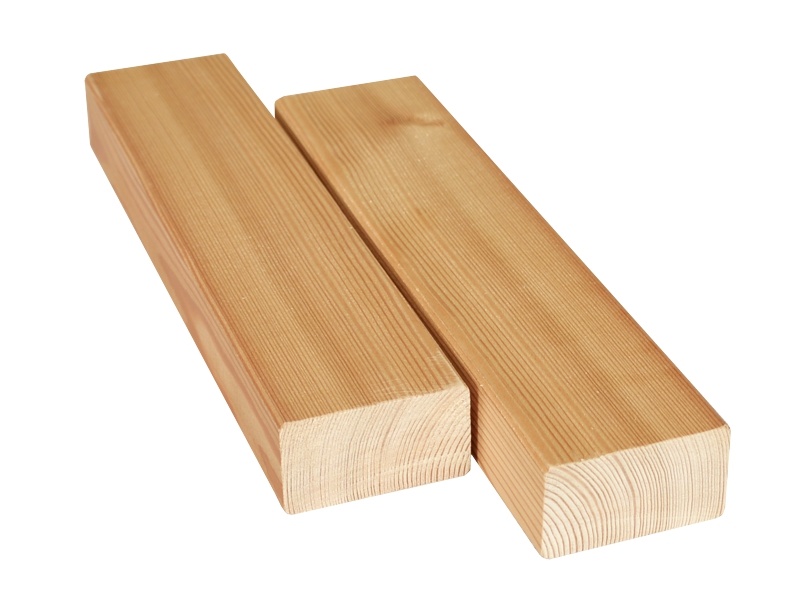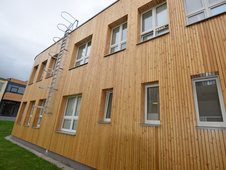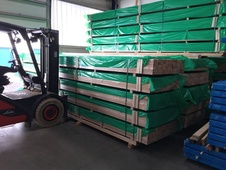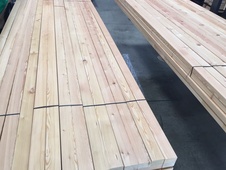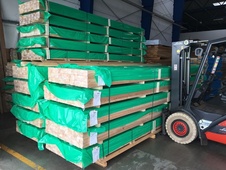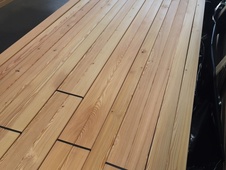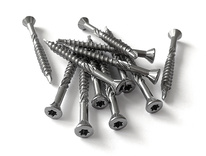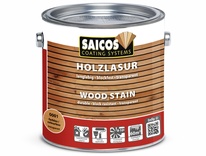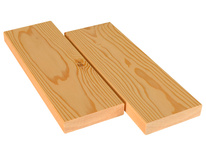Siberian larch 45x58 mm
Detailed Description
Siberian larch, profile 45x58 mm
Specie: Siberian larch
Botanical name: Larix sibirica
Origin: Russia
Size: 45x58x3000/4000/5100 mm
Density: approx 590 kg/m3
Durability class EN350: 3-4
Drying: KD
Grading: AB, knotty
Packing: 4 pcs
Profile: prism with eased edges
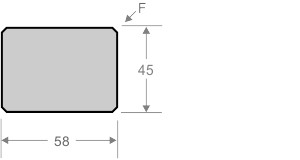
Specification points
About Siberian larch
Siberian larch, botanically called Larix sibirica, is a slow-growing conifer and is one of the most commonly used tree species for outdoor projects. It is a popular wood valued for its beautiful appearance, natural resistance, hardness and durability. Siberian larch naturally occurs from the northern regions of Europe, the Finnish border further east to central Siberia, where its name also comes to the southern border of Russia with Mongolia. It is a common species of wood, with larch accounting for 37% of Russia's total forests. Siberian larch is currently being replanted faster than harvested, making it a very sustainable choice. Siberian larch grows from the lowlands to an altitude of about 3600m in the Altai Mountains. From the 19th century, it also began to be artificially planted also in Canada and the USA.
This unique tree is able to withstand very adverse and cold temperatures and in adulthood it reaches a height of between 20 and 50 m and the diameter of its trunk is about 1 m. Summer in the taiga is short, but relatively warm. The winter is long and very cold. The extreme natural conditions that Siberian larch must face during its growth are the reason for its slow growth, dense annual rings, high density and many unique physical and mechanical properties, which will subsequently find use in the construction industry.
Siberian larch and its extracts have long been used for medicinal purposes in ancient times as well as today. Larch extracts and enzymes are still used to improve the body's defenses and strengthen the body. Resins are used to treat skin diseases and bud extracts help with inflammation of the upper respiratory tract. In ancient times, Siberian larch was used to make containers in which milk, butter and other foods did not spoil for a long time due to the antiseptic substances contained in the wood. In the past, larch was also used for fumigation during epidemics due to its positive energy. In magic, burning wood with wood or burning needles was used to avert adverse effects. Due to its positive energy, larch has long gained popularity in construction and the production of furniture and other wood products.
Properties
Siberian larch is one of the heaviest softwoods showing medium stability. For Siberian larch are characteristic apperiance of longitudinal cracks and cracks at the ends, depending on the outdoor climatic conditions, it is usual sign of this specie. Avoid contact of wood with metal or metal dust, which creates blue-black stains on the wood. Use only stainless steel fasteners for contact with and securing the wood. Siberian larch wood is less stable with significantly higher curvature compared to western red cedar, Canadian Douglas fir or thermo-modified ThermoWood. Due to this, it is recommended to carry out the assembly by screwing with screws for higher mounting strength. Nail mounting is not suitable. If the wood is left untreated or if the surface is not given sufficient care, weathering will change the color over time, most often to silver-gray. conditions, due to changing humidity and sun exposure conditions, there will be no uniform weathering and is likely to produce a dark, mottled, gray appearance.
Natural resistance and durability
Siberian larch is one of the soft woody plants, but thanks to its specific density of 590 kg / m3 it is one of the hardest softwoods in the world. With its hardness, density and natural durability, Siberian larch can be compared to a large group of hardwoods. Its natural resistance is also due to the high content of resin and preservatives. Siberian larch is very resistant to decomposition because it contains a high content of tannin. These resins and preservatives act as a natural antiseptic that is very repellent to insects. These resins and larch extracts are attributed to creating high resistance to rot, decay and wood-destroying fungi. Siberian larch is a durable tree that, thanks to its natural resistance, can be used for outdoor applications even without a protective coating. However, the use of a protective coating will extend its service life and increase the protection of the surface against contamination, the effects of UV radiation, cracking and other external influences.
High resin content
Resins are natural substances that trees naturally produce to protect themselves from pathogens and insects when damaged. The natural resistance of Siberian larch is due to the high content of resin and preservatives contained in the wood. Siberian larch is very resistant to decomposition because it contains a high content of tannin. The primary extractant in Siberian larch is Arabinoglactan, which is toxic to wood-destroying fungi. For this reason, Siberian larch is suitable for outdoor use. The resin content and the slow growth of Siberian larch ensure the connection of most knots with wood without falling out. Under certain conditions, for example due to higher temperatures, the high content of resins contained in the wood can flow onto the wood surface, especially in the summer months, because together with the higher temperature the wood structure opens to increased pressure inside the material and thus pushes the resin from its structure to the surface. Despite the surface treatment of the wood, the resin can migrate to its surface and further through the coating. This is a natural phenomenon in this unique tree.
Long life
Thanks to its high density of around 600 kg / m3 and natural resistance, Siberian larch provides a relatively long service life. Its lifespan is in the order of decades and some sources state that the lifespan of Siberian larch is more than 50 years. Due to its natural resistance to decomposition, high content of resins acting as a natural antiseptic repelling wood-destroying insects and extracts protecting against rot and fungi, it is one of the most resistant soft woody plants. The lifespan of wood that is exposed to the weather depends on many factors and varies depending on use and design. As with all other tree species, the durability of Siberian larch is affected by whether it is a walkable horizontal surface or vertical use, such as facade cladding, fences. An important factor influencing the life of wood is the correct installation, application of protective coatings, regular maintenance, overlaps of roofs protecting wood from exposure to UV radiation, rain, the possibility of drying and ventilation of wood and other aspects.
Color and appearance
Siberian larch wood has a beautiful texture with radial and tangential fiber structure with fine annual rings due to the slow growth of the wood. Due to the high resin content, the knots are firmly fused to this tree. The color of Siberian larch is golden, light reddish to light brown with various shades and, together with its favorable properties, is a popular and beaten tree. If the wood is exposed to external influences, especially solar UV radiation and rain, over time it will lose its original color and lead to the weathering process. The weathering process is most often manifested by graying of the wood. Due to the effects of humidity, fall and other climatic influences, the wood may darken or blacken in the same way as other woody plants. Dry cracks and other typical features of the wood appear on the wood surface. If you want to reduce the weathering process and prolong the original color of the wood, it is recommended to treat the surface with a suitable paint, preferably with pigments, and take care of the wood. More information about the care and care of wooden facades can be found in the technical information provided in this catalog and also on our website.
Download
Demand
We will show you our products before purchase in our warehouse. Wood is a natural material, each piece is a unique original. The supplied wood will be different from the displayed photos and samples.
Call us on +420 220 879 443
Payment options:
- Cash or a card at the store
- Cash on delivery (you pay when picking up the goods to the courier in the Czech area only )
- By bank transfer (we will send the goods immediately after the amount has been credited to our account)

